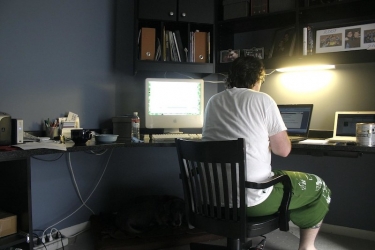Today's Wired Cio story was inspired by the thought-provoking question from a friend and former colleague who spoke about how her team is completely distributed now, and may never return to traditional office-based working. While there’s no doubting remote working provides huge flexibility and allows organisations to recruit the best people anywhere - with geography no longer a barrier - it’s still a manager’s job to keep up the energy, engagement, productivity, and harmony of their team.
For those organisations that were not born in the cloud - the vast bulk of businesses out there - the challenge is real. To a large extent, companies have tried to keep engagement through endless video conferencing meeting after meeting, but that’s not the solution. That’s a recipe for boredom, disinterest, and spending more time speaking about all the work that needs to be done instead of doing it.
"Engagement" is a hot-button word today but seemingly misunderstood. Engagement isn’t about how many meetings you sit through but about how involved in, enthusiastic about, and committed to, their work and workplace they are. Big drivers for these are a belief in the company’s mission, the transparency of the leadership and of colleagues, clarity in their role and activities, and regular feedback from management.
Staff turnover already carries real losses of knowledge and skills, and disengaged workforces only increase this financial and business loss. It’s vitally important a remote workforce is an inclusive and cohesive one no matter if it has always been remote, is newly remote, or whatever the case may be. A team is a team no matter the location.
|
|
Gallup has a 12 question survey it promotes to help measure employee engagement, and while some questions are expected - “do you know what is expected of you at work?” for example, others are less so - “do you have a best friend at work?” or “In the last seven days have you received recognition or praise for doing good work?”
Like most things in the world of IT, ultimately it boils down to communication. No matter the awesome technology and tools we have, every problem comes down to being a people problem. I don’t mean more meetings - goodness no - but during the meetings we already have make sure to find some time for small talk about hobbies and interests, and absolutely ensure successes and victories and personal milestones are made known and celebrated among the team.
The right tools also must come into play; Zoom, GoToMeeting, Google Meet, AWS Chime, and the rest are brilliant tools but video meeting after video meeting stifles productivity and drains people. Instead, consider the other array of tools at your disposal - casual chat applications, project management software, knowledge bases and documentation, task tracking systems, and the like.
Harness these to keep your team connected. Consider also the creative options that build up your virtual culture with good-hearted fun that bonds people together. Some companies have brought in a weekly Netflix watch party, others a Tik Tok-style challenge, and some play Jackbox games. Even a group vision board workshop can be a creative option.
In my own teams, I've always enjoyed interactive end-of-sprint retrospectives. One example is bringing in some balloons and markers and telling the team I want them to blow up the balloons and draw a face. Hilarity ensues. Yet, I find I need to pop half the balloons because they don’t meet my specification. Oh yes, that’s right, I wanted the face to have specific features. I didn’t tell you? Well, you didn’t ask, either … and thus the corollary to requirements gathering.
Obviously, this type of retrospective is rubbish when held over webcams (or even no cam), but Adam Weisbart’s Agile Ad-Libs have filled the gulf with humorous, and ice-breaking, collaborative stories that are paired with a serious retrospective question designed to foster good discussion and debate.

Another approach I have used to build teams is to work towards a professional certification together. In the office, we could study together, but in the remote working world we go over course materials in our own time and catch up during the week to work through practice questions and discuss the answers.
Whatever you do, remember managers must take the lead in creating a space where employees feel safe being their authentic selves.
The reason some companies succeed at remote working while others do not revolve around three C’s: communication, culture, and coordination. Develop and promote the company culture you want - and lead by example; keep in touch with your people and keep everyone connected, and use the right tools to make this happen.
Remember, while some managers may be uncomfortable with trusting remote employees, the greatest companies recognise this as the opportunity to allow workers to find their dream company, and for your dream employees to work for you - no matter where on the planet you all are.
Image credit: "Working from home" by ishane is licensed under CC BY 2.0






